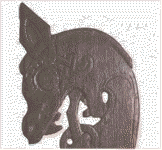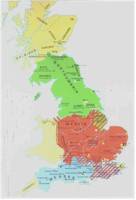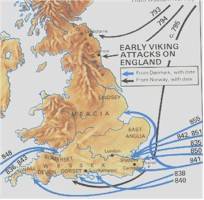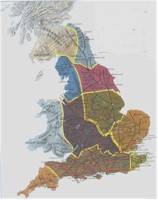- 410 to 1066
- Anglo Saxon Britain
- Viking raids
- the Norman invasion

|
 |
The breakdown of Roman law and civilisation was fairly swift after the Roman army departed in 410 AD. To counter the raids from continental pirates, Vikings, Picts and Scots towns would bring in mercenaries from Europe to defend them from attack. These mercenary soldiers were Angles and Saxons from northern Germany.
The deal was that the mercenaries brought their families with them, and got paid with land which they could farm. Eventually the Anglo Saxon mercenaries realised that they were stronger than their employers and appear to have taken over the running of areas themselves.
There is of course the whole legend of King Arthur that is ascribed to this period. Arthur appears to have been a fictional, rather than historical figure, but that link gives you a complete guide to King Arthur, who he could have been and where he could have lived.
 |
The new Anglo Saxon invaders were not organised centrally, as the Romans had been, or as the Normans would be. They slowly colonised northwards and westwards, pushing the native Celts to the fringes of Britain. Roman Britain was replaced by Anglo Saxon Britain, with the Celtic peoples remaining in Cornwall, Wales and Scotland. The Anglo Saxon areas eventually combined into kingdoms, and by 850 AD the country had three competing kingdoms as shown on the map on the left |
| The three kingdoms of Mercia, Northumbria and Wessex, not only were competing between
themselves, but they were also under sustained attack from Viking raids. The Viking
incursions culminated with a "Great Army" landing in East Anglia in 865 AD. It
made wide territorial gains, and by 875 the kingdoms of Mercia and Northumbria had
succumbed. Only Wessex remained as Anglo Saxon. The Vikings attack Wessex in 878, and the Saxon king, Alfred (of burning the cakes fame) had to flee to the Somerset marshes.. However he was able to regroup and counter attack. His efforts and those later of his son and grandsons, gradually pushed the Vikings (remember Eric Bloodaxe) northwards and eventually into the sea. By 955, Alfred the Great's grandson Eadred, ruled over a united England. Government became centralised, and the king had the infrastructure to rule the whole country |
 |
 |
Next came another wave of Viking attacks. The net effect was that the English kin, Ethelred the Unready, found his kingdom under attack on all coasts by Norsemen. On Ethelred's death in 1016, the Viking leader Cnut was effectively ruling England. But on Cnut's death, the country collapsed into a number of competing Earldoms (shown on the left) under a weak king, Edward the Confessor. |
| The strongest of these earls was Harold, Earl of East Anglia. Through a series of
battles and intermarriages, Harold controlled Wessex and was in a powerful position. So
when Edward the Confessor died in 1066 without a male heir, Harold claimed the throne. His claim was disputed by William, Duke of Normandy, whose claim to the English throne was even more tenuous than Harold's |
 |
 |
There were two major influences on English life during this whole period
of English history, at opposite ends of the aggression spectrum. One was the coming of Christianity to Britain, brought by Irish monks to places like Lindesfarne in 635, or Iona in Scotland in 563. The church had organised the whole country into diocese, each under a bishop, by about 850 The other was the Viking raider. And it was the Viking raider that paradoxically allowed William to conquer Britain |
 |
When Edward the Confessor died, the Vikings saw a chance to regain a foothold in Britain, and landed an army in Yorkshire in 1066. Harold marched north to take on the Vikings under Harald of Norway and Tostig (King Harold's brother).He defeated the Norsemen near York, but while celebrating his victory, learnt that William of Normandy had landed in southern England.
Within 13 days he had marched his army some 240 miles from Yorkshire to Sussex, where the Normans were camped near Hastings. The ensuing Battle of Hastings was won by the Normans who were fresh, and had better archers and cavalry. Harold died with an arrow through his eye. William was crowned William I in London on Christmas Day 1066
| Go on to next history page the Normans | |
| Main History page return to main History of Britain page | |
| Great Britain Great Britain front page |